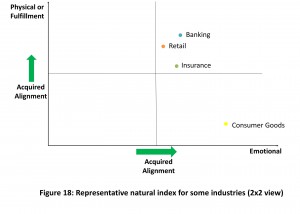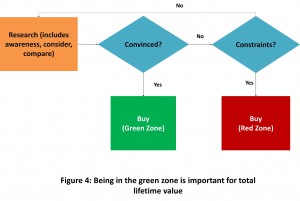
We are making great strides in connecting with customers and consumers in an Omni Channel fashion. A major part of that evolution is about bringing together a seamless experience over mobile, social media, in-store, online etc.. We are already seeing solutions that help the different channels be aware of each other. Some examples are:
1. For a contact center representative to be aware of the customers online or in-store history
2. For a consumer to receive mobile offers based on their proximity to a store and what’s on their wish list
3. For an in-store associate to be able to create a better customer experience based on pulling together historical, social and preference information (“In-store clienteling”).
However, we should also keep in mind that one of the original challenges with customer relationships still need to be solved. The primary challenge is that of treating the customer as a relationship and harnessing every promotion or campaign as just one incremental step of an overall strategy.
Social media and mobile have opened the doors to an exciting new paradigm which primarily consists of moving beyond the traditional “fire and re-energize” marketing. In that old model, every promotion caused a demand spike, which attenuated over a period of time, only to be propped up again by another campaign. We mastered that type of campaign – running analytics to understand customer responses, preempting competitive promotions, devising bundling strategies, sending coupons to lure the customers in and a host of other very effective tactics. But today, we have a choice to dramatically improve upon that strategy by proactively engaging customers and effectively utilizing the abundance of information that customers themselves are willing to provide to us. In any win-win situation, customers and sellers work together.
The Customer Interaction Index
In my book, “Dancing the Digital Tune”, I introduced an index or parameter that measures the potential and maturity of customer interaction on both the emotional as well as physical / fulfillment aspects.
 Different kinds of companies are set up differently to harness the Customer Interaction Index. For example, banks and credit cards have an inherently high Customer Interaction Index. They can create avenues of highly engaging physical interaction, as well as create a reasonably high emotional connect with the consumer. On the other hand, Consumer Goods companies have an intrinsically lower Customer Interaction Index because their primary connect with the consumer is on the emotional or branding level. This means that consumer goods firms must find newer ways to embed themselves into the customer’s purchase cycle. They should also find innovative ways to create switching barriers.
Different kinds of companies are set up differently to harness the Customer Interaction Index. For example, banks and credit cards have an inherently high Customer Interaction Index. They can create avenues of highly engaging physical interaction, as well as create a reasonably high emotional connect with the consumer. On the other hand, Consumer Goods companies have an intrinsically lower Customer Interaction Index because their primary connect with the consumer is on the emotional or branding level. This means that consumer goods firms must find newer ways to embed themselves into the customer’s purchase cycle. They should also find innovative ways to create switching barriers.
The higher the index, the higher the strength of our relationship with the customer is. The key factors that define the outcomes are:
- Price to value perception – what price premium will the customer be willing to accept for the perceived value of the product versus products from competition
- Inclusion in the purchase cycle – how does our product integrate with the key factors that trigger the customer to purchase and use our product
- Switching barriers – how easy is it for a customer to switch to another product
- Cause of purchase – how well does the product forecast and insert itself into the causes that require consumption of the product category
Marketing in the new paradigm
The emerging mobile and social media channels provide us with effective ways to improve the Customer Interaction index. It is important that we utilize the opportunity to move away from the “fire and re-energize” approach. Here are some common ways to leverage the full potential of the connected age:
- Connect every new campaign to the previous one. Do you remember how the customer responded to your last campaign or do you lose that personal information among the mass segmentation analysis of your current channels? Its important to find ways to link to individual customers rather than en-masse.
- Create avenues that connect your product to the customer purchase cycle. Are you reaching your customers when they are in the midst of their purchase cycle or after they’ve decided to buy?
- Build a memory of transactions to increase switching barriers. Is a customer’s decision linked to the price and the inherent perception of your quality or do they have to make larger sacrifices if they buy from a competitor?
- Provide returns to customers that pre-empt price promotions and volume discounts. Is your promotion strategy merely training customers to look for the next discount or are they participating in a larger ecosystem enabled by their purchase?
The exact tactics for enabling the above will depend on the type of product and the type of interactions. The key to that will be a personal Customer Interaction Index rather than aggregated segmentation techniques. Companies, who seem apparently at a disadvantage from an interaction perspective, actually do have a rich array of options. A step in the direction of building an ecosystem will prove to be highly rewarding.
A new baseline of customer engagement
While mobile and social media are excellent avenues for enhancing your Customer Interaction Index, new marketing strategies must be adopted. Sending coupons to customers mobiles, or making coupons available on Facebook will no doubt bring returns, but significant value will be left on the table. Creating events and inviting customers to participate in campaigns will be a step in the right direction. But the crucial next step will be to convert this engagement into tangible revenue, retention or sales metrics. To achieve that goal, we will have to embed ourselves into the customer’s purchase cycle through content marketing, creation of communities, providing seamless re-order avenues, getting included in to wish-lists, etc. For almost all products, from diapers to toothpaste, to cheese to a vacation, and even a home loan, it means creating an ecosystem that gets the target customers into a long running campaign and keeps them engaged with relevant tools and attractions.
In such a scenario, what we have achieved through promotions before becomes a new normal for us. A promotion is then used to get a spike in already high customer engagement level, not to attract and engage customers from scratch.
Creating such an ecosystem cannot be prescriptive and varies based on the quality and other value drivers for a product. The key question to answer at every stage is: What are the events that lead to the purchase and how can we influence them? Subsequently sending a coupon when a customer is in the store is a sub-optimal option. This trains customers to expect more discounts. Instead, the right option is to influence a customer’s decision before they get to the store (or go online).
Please do share what you think. What methods do you recommend towards the goal of creating excellent customer engagement?
– Photo credit: mugley / iW / CC BY-NC-ND
– Based on the 5 principles outlined in my book “Dancing the Digital Tune”

